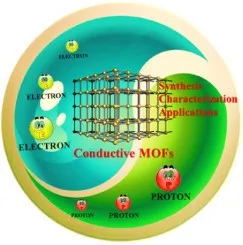
hotline:
17715390137
Tel/Wechat:
18101240246 (Technology)
0512-68565571
Email:mxenes@163.com (Sales Engineer)bkxc.bonnie@gmail.com
Scan the code to follow or search the official account on WeChat:
2D Materials Fronrier After paying attention,
click on the lower right corner to contact us,
Enter enterprise WeChat.
Professional Services Online

 Conductive MOF
Conductive MOF
Li Wenhua, Deng Weihu, Wang Guan‘e, Jiang Gang
EnergyChem is available online March 7, 2020, 100029
https://doi.org/10.1016/j.enchem.2020.100029
Metal organic framework (MOF) / porous coordination polymer (PCP) has become a new type of conductive solid material, including in fuel cells, batteries, super capacitors, catalysts, sensors, electronics, thermoelectricity, and spin electronics. Only in the last ten years have novel strategies been developed that can rationally design electronic and proton conducting MOFs. In this review, recent advances in MOF-based electronic and proton conductors are summarized and highlighted, including material preparation, conductivity measurement, electrical conduction mechanisms, and applications. In addition, important breakthroughs in charge and proton transport conductors based on MOF, as well as the status quo and challenges in this field are described.
https://www.sciencedirect.com/science/article/pii/S258977802030004X
Under the role of metal-organic framework, effective metal ion screening can rectify sub-nanometer channels
Army, Zhang Huacheng, Hou Jue, Li Xingya, Hu Xiaoyi, Hu Yaoxin, Christopher D. Easton, Li Qinye, Sun Chenghua, Aaron Thornton, Matthew Hill, Zhang Xiwang, Jiang Gengping, Liu Jason, Anita J. Hill, Benny D. Freeman, Jiang Lei and Wang Huanting
Natural Materials (2020)
Biological ion channels have significant ion selectivity, permeability, and rectification properties, but developing artificial analogs is challenging. Here we report a metal-organic framework-based sub-nanometer channel (MOFSNC) with heterostructure and surface chemistry that can achieve these properties. The asymmetric structure of MOFSNC can rapidly conduct K +, Na + and Li + in the direction of sub-nanometer to nanometer channel, and its conductivity is three orders of magnitude higher than that of Ca 2+ and Mg 2+, which is equivalent to mono / divalent ion selection Sex is 103. The ion selectivity can be further adjusted from 102 to 104 by changing the pH from 3 to 8. Theoretical simulations show that the interaction of ions with carboxyl groups greatly reduces the energy barrier of monovalent cations through MOFSNC, resulting in ultra-high ion selectivity. These findings suggest ways to develop ion-selective devices for efficient ion separation, energy retention, and power generation.
https://www.nature.com/articles/s41563-020-0634-7
Electrochemically active sites inside crystalline porous materials for energy storage and conversion
Kong Lingjun, Zhong Ming, Shuang Shuang, Xu Yunhua, Bu Xianhe
Submitted on December 13, 2019
First released March 10, 2020
Chemistry Soc. Revised 2020, Advanced Article
The design and development of crystalline porous materials (CPM), including metal organic framework (MOF) and covalent organic framework (COF), have been extensively studied due to their regular crystal lattice and well-defined pore structure. In recent years, a large amount of research work has been performed using CPM as a sacrificial template for manufacturing electrochemical functional materials. The inherently active electrochemical sites in CPM are particularly abundant and are being explored for electrochemical reactions. In this review, the electrochemically active sites inside the CPM and the surrounding space (metal ions, ligands, crystal structures, pores, and morphology) are the focus and latest developments in the field of metal ion batteries, metal-air batteries, and water decomposition. . Other related electrochemical devices have been outlined. In summary, this review provides the rationale for the design and regulation of active sites (such as redox-active metal clusters and organic ligands) and the space around electrochemically active sites and their applications in electrochemical energy storage and conversion systems. Guidelines for preparing electroactive CPM. .
https://pubs.rsc.org/en/content/articlelanding/2020/cs/c9cs00880b
Source: MOFs Online

| Reminder: Beijing Beike New Material Technology Co., Ltd. supplies products only for scientific research, not for humans |
| All rights reserved © 2019 beijing beike new material Technology Co., Ltd 京ICP备16054715-2号 |